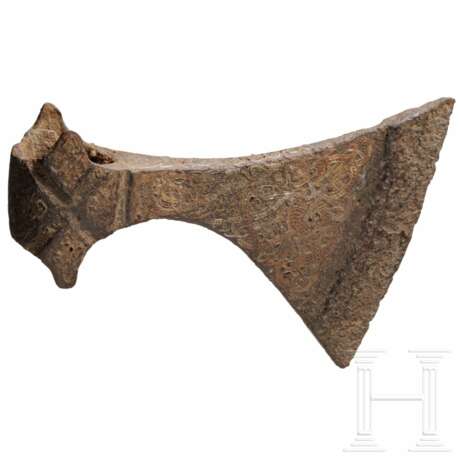ID 1323366
Lot 4155 | Wikingische Streitaxt mit reicher Tierstilverzierung im Jellinge-Stil, 10. Jhdt.
Streitaxt mit oben und unten spitz ausgezogenen Lappen auf beiden Seiten der Schaftröhre, die im Nacken glatt und ohne Fortsatz ist. Die Klinge der Axt verbreitert sich leicht geschwungen nach oben und unten zur deutlich abgesetzten, ca. 3 cm breiten Schneide hin, die an der Basis gegenüber der Klinge nochmals verdickt ist. Die Schneide zur Unterseite hin leicht einwärts gebogen. Auf der Schaftröhre beidseitig zwei gekreuzte Hohlkehlen, eine senkrechte Hohlkehle direkt davor. Die Beilklinge sowie die Schaftröhre mit Einlegearbeiten aus Gold und Silber in höchster Qualität verziert, die exquisite Beispiele nordischer Tierornamentik im Jellinge-Stil darstellen: Auf den beiden Seiten der Klinge vom Ansatz bis zur Schneide vollflächig ein kompliziertes Geflecht aus ineinander verschlungenen Tierleibern, deren Köpfe mit weit aufgerissenen Kiefern in die Tierkörper beißen. Ineinander verbissene Tier auch im Nacken der Axt, links und rechts flankiert von Flechtband. In den Kompartimenten zwischen den Hohlkehlen auf den Seiten der Schaftröhre gleichfalls Flechtbänder. Die Unterseite der Axt unverziert, die Oberseite hingegen mit einem komplex konstruierten, langdreieckigen Flechtband. Höhe der Schneide 14,2 cm. Länge der Axt 21 cm. Oberfläche mit leichten Korrosionsnarben. Die Eisensubstanz stabil. Die Einlagen partiell mit Verfärbungen durch Oxyde auf der Oberseite, aber vollständig und ohne Fehlstellen erhalten.
Außergewöhnlich schönes, seltenes und vor allem gut erhaltenes Beispiel einer wikingischen Prunkaxt.
Provenienz: Süddeutsche Privatsammlung, übernommen in den späten 90er Jahren aus der Sammlung des Vaters.
A Viking battle axe with lavish animal-style decoration in the Jelling style, 10th century
A Viking battle axe with lavish animal-style decoration in the Jelling style, 10th century
The battle axe with pointed lobes at the top and bottom on both sides of the shaft tube, which is smooth at the neck and without extension. The blade of the axe widening and curving slightly up and down to a clearly delineated cutting edge, approx. 3 cm wide, which is thicker again at the base opposite the blade. The cutting edge curving slightly inward towards the underside. Two crossed, shallow fullers on both sides of the shaft tube, one vertical groove directly in front. The axe blade and the shaft tube are decorated with inlays of gold and silver in the highest quality, representing exquisite examples of Nordic animal ornamentation in the Jelling style: on both sides of the blade, from the base to the cutting edge, is a complex network of interlaced animal bodies, the heads of which are biting into the other bodies with wide-open jaws. Another such intertwined, biting animal on the neck of the axe, flanked by a braided band to the right and left. Repeated braided bands in the compartments between the fullers on the sides of the shaft tube. The underside of the axe is undecorated; however, the upper side features a long, triangular braided band of elaborate construction. Height of the cutting edge 14.2 cm. Length of the axe 21 cm. The surface with minimal corrosion pits. Stable iron substance. Some of the inlays with discolouration due to oxides on the top, but completely preserved and without defects.
Exceptionally beautiful, rare example of a Viking axe, first and foremost in good condition.
Provenance: South German private collection, inherited from the collection of the consignor's father in the late 1990s.
Condition: II +
| Auction house category: | Migration period and early middle ages |
|---|
| Auction house category: | Migration period and early middle ages |
|---|
| Address of auction |
Hermann Historica Bretonischer Ring 3 85630 Grasbrunn / München Germany | ||||||||||||||
|---|---|---|---|---|---|---|---|---|---|---|---|---|---|---|---|
| Preview | |||||||||||||||
| Phone | +49 (0)89 5472 649 0 | ||||||||||||||
| Fax | +49 (0)89 5472 64999 | ||||||||||||||
| Buyer Premium | 25 % | ||||||||||||||
| Conditions of purchase | Conditions of purchase | ||||||||||||||
| Business hours | Business hours
|



